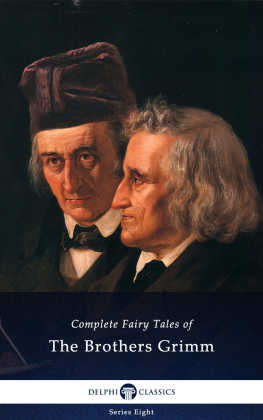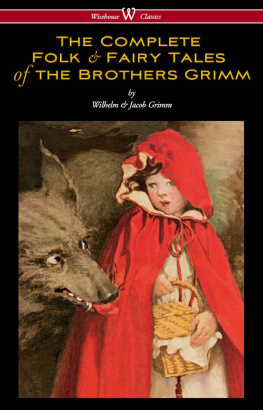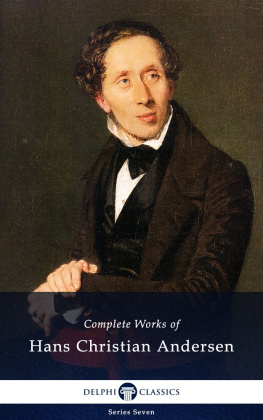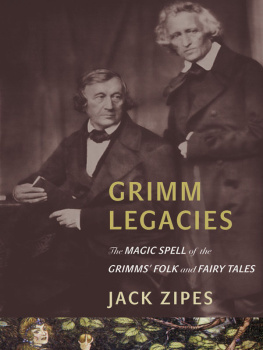
The Collected Works of
THE BROTHERS GRIMM
Jacob (17851863) and Wilhelm Grimm (17861859)

Contents

Delphi Classics 2017
Version 1

The Collected Works of
THE BROTHERS GRIMM

By Delphi Classics, 2017
COPYRIGHT
Collected Works of the Brothers Grimm
First published in the United Kingdom in 2017 by Delphi Classics.
Delphi Classics, 2017.
All rights reserved. No part of this publication may be reproduced, stored in a retrieval system, or transmitted, in any form or by any means, without the prior permission in writing of the publisher, nor be otherwise circulated in any form other than that in which it is published.
ISBN: 978 1 78656 091 9
Delphi Classics
is an imprint of
Delphi Publishing Ltd
Hastings, East Sussex
United Kingdom
Contact: sales@delphiclassics.com
www.delphiclassics.com
Interested in Fairy Tales?
Then youll love these eBooks:

These comprehensive editions are beautifully illustrated with the original artwork of some of the greatest children stories ever told, as well as offering a dazzling array of Delphi bonus features. Now you can rediscover the magic of these eternal classics on your eReader!
Explore Classic Childrens eBooks
The Fairy Tales

Hanau, a town in Main-Kinzig-Kreis, Hesse, Germany, located 25km east of Frankfurt the birthplace of the Bothers Grimm

The birthplace was destroyed by the devastating Allied land bombardment of 19 March 1945, which affected the entire inner city of Hanau. The site of birthplace is on the south side of the Paradeplatz (later used as a police building and Landratsamt) and is now marked only by a memorial stone on the opposite side of the road.
GRIMMS FAIRY TALES

Published originally under the title Kinder- und Hausmrchen ( Childrens and Household Tales ), this collection of fairy tales was first published in 1812 by the Grimm brothers, Jacob and Wilhelm. The first volume of the first edition featured 86 stories, with a second volume of 70 stories following in 1815. For the second edition, two volumes were issued in 1819 and a third in 1822, totalling 170 tales. Numerous tales were added to each subsequent edition, until the seventh edition contained 211 stories. All editions were extensively illustrated, first by Philipp Grot Johann and, after his death in 1892, by German illustrator Robert Leinweber.
The rise of romanticism in the early nineteenth century revived interest in fairy tales, which had declined since the late seventeenth century. Johann Karl August Musus had published a popular collection of tales between 1782 and 1787, and so the Grimms aided the revival with this famous collection, building on the conviction that a national identity could be found in popular culture and with the common folk. They collected and published tales as a reflection of German cultural identity. In the first collection, though, they included Charles Perraults tales, published in Paris in 1697 and written for the literary salons of an aristocratic French audience.
The first volumes roused much criticism as they were called Childrens Tales, though they were not regarded as suitable for children, both due to the scholarly information included with the text and the subject matter. Many changes through the editions were made, removing violent and sexual references. The wicked mother of the first edition in Snow White and Hansel and Gretel was subsequently changed to a stepmother. In 1825, the Brothers published their Kleine Ausgabe (small edition), a selection of 50 tales designed for child readers, which went through ten editions between 1825 and 1858.
The brothers were directly influenced by Brentano and von Arnim, who edited and adapted the folk songs of Des Knaben Wunderhorn (The Boys Magic Horn or cornucopia). They began the collection with the purpose of creating a scholarly treatise of traditional stories and of preserving the stories as they had been handed from generation to generation a practice they saw as being threatened by increased industrialisation. The Grimms appropriated stories as being uniquely German, such as Little Red Riding Hood, which had existed in many versions and regions throughout Europe, as they believed such stories were reflections of Germanic culture. Furthermore, the brothers saw fragments of old religions and faiths reflected in the stories, which they argued would continue to exist and survive through the telling of stories.
The brothers gained a reputation for collecting tales from peasants, although many tales came from middle-class or aristocratic acquaintances. Wilhelms wife Dortchen Wild and her family, with their nursery maid, told the brothers some of the more well-known tales, such as Hansel and Gretel and Sleeping Beauty. Wilhelm collected a number of tales after befriending August von Haxthausen, whom he visited in 1811 in Westphalia where he heard stories from von Haxthausens circle of friends. Several of the storytellers were of Huguenot ancestry, telling tales of French origin such as those told to the Grimms by Marie Hassenpflug, an educated woman of French Huguenot ancestry and it is probable that these informants were familiar with Perraults Histoires ou contes du temps pass (Stories from Past Times). Other tales were collected from Dorothea Viehmann, the wife of a middle-class tailor and also of French descent. In spite of her middle-class background, in the first English translation she was characterised as a peasant and given the name Gammer Gretel.
The work of the Brothers Grimm influenced other story collectors, both inspiring them to collect tales and leading them to similarly foster a spirit of romantic nationalism, which upheld that the fairy tales of a country were particularly representative of it, to the neglect of cross-cultural influence. Among those influenced were the Russian Alexander Afanasyev, the Norwegians Peter Christen Asbjrnsen and Jrgen Moe, the English Joseph Jacobs and Jeremiah Curtin, an American that collected Irish tales.

Frontispiece and title page of the second edition, 1812

Next page



















